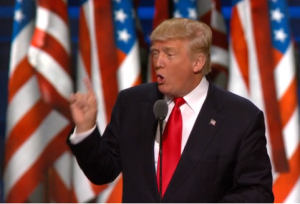Fact-Checking Donald Trump’s Remarks on Taxes, Debt and Crime
< < Go Back
Donald Trump said he would cut taxes, tackle the national debt, and sharply reduce crime and violence against police in his speech to the Republican convention Thursday night. Here’s a closer look at his plan and the figures he cited in making his case.
TAXES
Donald Trump says he has proposed the largest tax reduction of any candidate in this campaign, which independent analyses peg at about $10 trillion over a decade, reducing federal tax collections by about 22%.
His campaign is actually exploring making the tax cut smaller, down to about one-third of its original size. they’ve also said they want to make the plan more tilted toward the middle class.
Mr. Trump said the U.S. is “one of the highest-taxed nations in the world.” He has said this before and it is still wrong.
Compared with other large industrialized nations, the U.S. is, in fact, a low-tax country. In 2014, according to the most recent data, the U.S. federal state and local governments collected a total of 26% of gross domestic product in taxes, below the average of 34.4% for about 30 nations, which also typically provide more generous social benefits, according to the Organization for Economic Cooperation and Development.
The U.S. does have the world’s highest statutory corporate tax rate, at 35%, which distorts business decisions.
NATIONAL DEBT
Mr. Trump said the national debt has almost doubled to more than $19 trillion under President Barack Obama. That’s roughly true. The debt was at about $10 trillion eight years ago and is now more than $19 trillion, though that includes intra-governmental holdings held by government trust funds.
A better gauge than the nominal debt number is the debt-to-GDP ratio. This, too, has doubled since before the 2007-09 financial crisis, to around 75% of GDP. It’s now near the highest level since World War II.
The budget deficit, however, has returned back to where it was before the recession. It now stands at less than 3% of GDP, near the long-run average. One big reason for this is that interest rates have remained low, reducing government borrowing costs.
CRIME AND POLICE
Mr. Trump said that “decades of progress made in bringing down crime are now being reversed by this Administration’s rollback of criminal enforcement,” and cited a big increase in murder in major cities.
Indeed, after years of declines, homicides rose in 2015 in major cities. While the murder rates in most cities are nowhere near the levels of the 1990s, a survey by the Major Cities Chiefs Association did show increases last year in 44 of the 65 largest police agencies, including New York City, Los Angeles and Chicago. In many of the cities, it was the first time homicides had risen in years.
Finally, according to the National Law Enforcement Officers Memorial’s preliminary statistics gun-related deaths are up 78%, from 18 in July 2015 to 32 so far this year.
More From The Wall Street Journal (subscription required):




